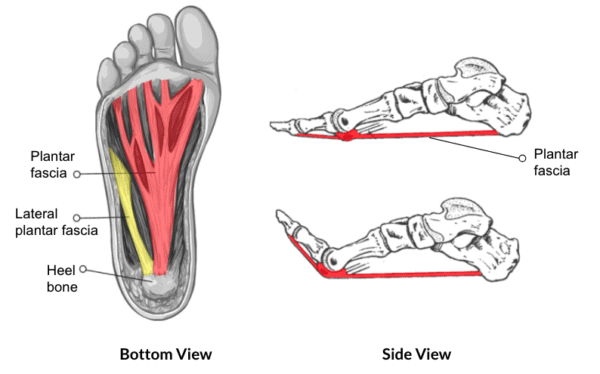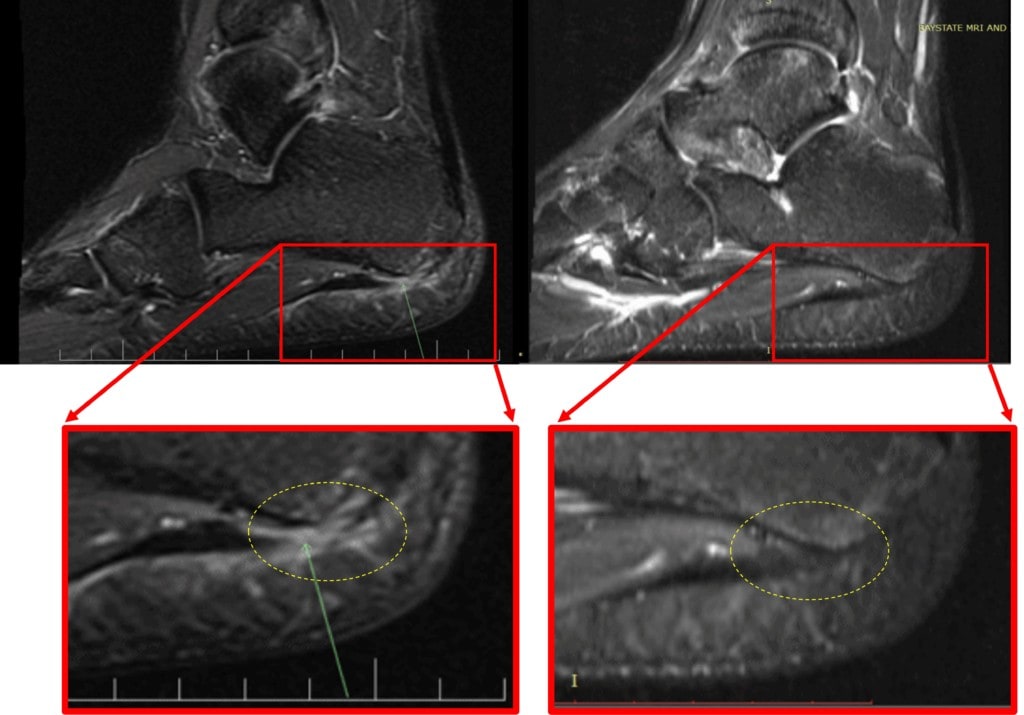What Is a Plantar Fascia Tear?

In this article:
- What is a plantar fascia tear?
- How do you know if you have one?
- How is it diagnosed?
- What are treatment options?
- Understanding types of tears and treatments
- Plantar fascia tear not healing (patient story)
Your foot has an arch that allows it to act as a spring that returns energy when running. If the foot didn’t have that ability, every step would feel like you were slogging through deep mud because the energy would be lost. In other words, the arch helps your foot to efficiently walk or run.
What holds up the arch of the foot and allows that energy to spring back from the ground? One of those things is the plantar fascia, a fibrous and elastic ligament that runs along the bottom of your foot as shown below in red:

What Is a Plantar Fascia Tear Or Rupture?
The plantar fascia is a thick, fibrous band similar to a ligament. As such, it can be torn, typically where it attaches at the heel (1). As shown above, there are two parts (the main band and the lateral band) that go from the heel to the slips that attach to the toe joints. The plantar fascia can also tear at its midsubstance as well as where it attaches to the toes.
Unlike plantar fasciitis, which is when the heel area is painful and develops micro-tears, a plantar fascia rupture or tear happens due to trauma and that can be pinpointed on MRI.
How Do You Know If You Have A Torn Plantar Fascia?
Usually, you will experience intense heel pain or arch pain (or a “pop”) due to some sort of trauma. This continues when you walk on the foot, and it gets worse when the toes are bent upward. There may be a painful lump or bump where the pain is located. The pain may be sharp or feel like something tearing or ripping when you walk.
If you ice the area and elevate it and the pain goes away in a few days, it’s likely a small tear that is healing. However, if the pain continues and you’re unable to return to normal activities within a week, then it’s time to get this checked out.
How Is A Torn Plantar Fascia Diagnosed?
Your doctor may recommend getting an X-ray to rule out a local fracture. If nothing is found on the X-ray, then the next step is an MRI. MRIs are highly sensitive and great at revealing tears, but if that’s not clear, ultrasound imaging may also help.
What Are Plantar Fascia Tear Treatment Options?
The most common treatment is rest, ice, elevation, and sometimes bracing. A walking boot and/or crutches may be used to take pressure off the area and allow it to heal. Nonsteroidal anti-inflammatory drugs (NSAIDs) like ibuprofen and naproxen and others are often used. If after four to six weeks the condition hasn’t improved, other treatments options include:
Steroid Injections
Please don’t let any provider inject steroids into the torn area. While this may make the area feel better by suppressing inflammation, it will reduce the healing ability of the plantar fascia. You can learn more about the risks of steroid injections here.
Platelet-Rich Plasma (PRP) Injection:
This procedure is used to prompt smaller tears to heal. It involves taking blood from the patient and then concentrating the healing platelets to make platelet-rich plasma. This is then precisely injected into the tear using ultrasound imaging.
Bone Marrow Concentrate (BMC) Injections
This is used for bigger tears and involves taking bone marrow aspirate from the back of the hip because this area contains stem cells. The aspirate is centrifuged to isolate the stem cell fraction.
Surgical Repair
This is an invasive open surgery where the tear is sewn back together.
Understanding Tear Types as It Relates to Treatment
Your MRI report showing a plantar fascia tear may prompt anxiety, but it really shouldn’t. Why? Most physicians don’t mention whether the tear is the type amenable to nonsurgical methods to prompt healing. What do I mean?
There are three types of tears:
- Partial – This is when only a part of the plantar fascia is torn. It’s usually treated with PRP.
- Complete nonretracted – This is when the tear is all the way through the plantar fascia, but it has not snapped back like a rubber band. These tears have remaining fibers still holding the plantar fascia together. In my experience, the best treatment here is the use of bone marrow concentrate injections.
- Complete retracted – This is a tear that is massive, and the plantar fascia has retracted back like a cut rubber band. This condition is only treatable with surgery.
How do you know which type of tear you have? You need to see a specialist in nonsurgical treatment, which usually isn’t a podiatrist or orthopedic surgeon. Why? Because, in my experience, surgeons will take partial and complete nonretracted tears that should be treated nonsurgically and often choose to operate on them. That’s why you need to be proactive.
Plantar Fascia Tear Not Healing: Patient Story
Chris is a collegiate soccer player who injured his right heel in a soccer match in late June of 2021. He treated it with ice and rest and was almost back to normal when he reinjured it in the subsequent match a week or so later.
When Chris first saw Dr. Dan Southern, at our Connecticut Regenexx clinic in July, he was limping and had pain in the bottom of the right heel. Chris couldn’t run or jump or play soccer.
On his physical exam, he was having pain focused solely in the heel. There was no instability in the ankle, and his X-ray was unremarkable, which means it looked normal. An MRI showed a 10 millimeter tear in the lateral band of the plantar fascia near the heel. This was treated with bone marrow concentrate injection using precision ultrasound guidance. His foot was placed in a controlled ankle movement (CAM) walker boot and he was sent to physical therapy. At just four weeks after the treatment, he began progressive weight-bearing exercise.
His follow-up MRI was taken 11 weeks after the bone marrow concentrate injection. The heel showed no visible tear, with reorganization of fascial fibers attaching to the calcaneus (see below):

The BEFORE MRI above on the left shows a tear (white area in the dark plantar fascia in the yellow dashed oval). The AFTER image shows a normally dark plantar fascia and was read out as a normal image.
Chris was persuaded not to play in the final match of the season that took place two months after the injections. As a result, he was redshirted for the season and maintained eligibility. He was running, jumping, and kicking a soccer ball with no pain at all just four months after the injection. He was preparing for spring soccer when he was last checked.
The upshot? Plantar fascia tears happen, but most of them do not call for surgery. So if the tear doesn’t heal on its own, it’s time to consider seeing a nonsurgical specialist to determine if you have the type of tear that requires surgery or one that can be healed through a much less invasive injection.
Click here to find a Regenexx doctor near you who can treat plantar fascia tears nonsurgically
________________________________
References
(1) Debus F, Eschbach D, Ruchholtz S, Peterlein CD. Rupture of plantar fascia: Current standard of therapy: A systematic literature review. Foot Ankle Surg. 2020 Jun;26(4):358-362. doi: 10.1016/j.fas.2019.05.006. Epub 2019 May 14. PMID: 31176530.

If you have questions or comments about this blog post, please email us at [email protected]
NOTE: This blog post provides general information to help the reader better understand regenerative medicine, musculoskeletal health, and related subjects. All content provided in this blog, website, or any linked materials, including text, graphics, images, patient profiles, outcomes, and information, are not intended and should not be considered or used as a substitute for medical advice, diagnosis, or treatment. Please always consult with a professional and certified healthcare provider to discuss if a treatment is right for you.